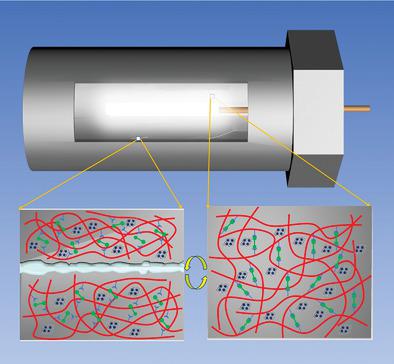当前位置:
X-MOL 学术
›
Macromol. Mater. Eng.
›
论文详情
Our official English website, www.x-mol.net, welcomes your
feedback! (Note: you will need to create a separate account there.)
Facile Repair of Anti-Corrosion Polymeric Composite Coatings Based on Light Triggered Self-Healing
Macromolecular Materials and Engineering ( IF 4.2 ) Pub Date : 2021-08-02 , DOI: 10.1002/mame.202100106 Yue Ma 1, 2, 3 , Yuman Yang 1, 2, 3 , Daruo Cao 1, 2, 3 , Jun Fang 1, 2, 3 , Cheng Zhu 1, 2, 3 , Meng Yang 1, 2, 3 , Liang Fang 1, 2, 3 , Chunhua Lu 1, 2, 3 , Zhongzi Xu 1, 2, 3
Macromolecular Materials and Engineering ( IF 4.2 ) Pub Date : 2021-08-02 , DOI: 10.1002/mame.202100106 Yue Ma 1, 2, 3 , Yuman Yang 1, 2, 3 , Daruo Cao 1, 2, 3 , Jun Fang 1, 2, 3 , Cheng Zhu 1, 2, 3 , Meng Yang 1, 2, 3 , Liang Fang 1, 2, 3 , Chunhua Lu 1, 2, 3 , Zhongzi Xu 1, 2, 3
Affiliation

|
Photothermally induced self-healing coatings are widely reported, while their application scenarios are rarely taken with concern. In addition, there is a need to achieve the balance between good properties and self-healing behaviors for closing the gap between academic research and engineering applications. Here, self-healing composite coatings are designed based on silane-modified epoxy chains with reversible crosslinking points and multifunctional fillers of cerium oxide nanoparticles grown on graphene nanosheets, and their applications are demonstrated for restricted regions. Diglycidyl ether-terminated poly(dimethylsiloxane) is co-polymerized with diglycidylether of bisphenol A with the weight ratio of 1/99–10/90 to achieve surface-tension driven crack closure, while dangling furan groups contribute to reversible crosslinking points via Diels–Alder reaction. Cerium oxide nanoparticles and graphene nanosheets enhance anti-corrosion properties, and graphene nanosheets also act as photothermal fillers. The results show that pencil hardness, polarized resistance, and coating resistance are highly improved via the introduction of multifunctional fillers at 1 and 2 phr. Good thermally and photothermally induced self-healing is demonstrated. This work provides a new application thought for light triggered self-healing coatings that can be used for restricted regions including inner walls of pipelines and reactors.
中文翻译:

基于光触发自修复的抗腐蚀聚合物复合涂层的简易修复
光热诱导的自修复涂层被广泛报道,而它们的应用场景很少受到关注。此外,还需要在良好的性能和自愈行为之间取得平衡,以缩小学术研究和工程应用之间的差距。在这里,基于具有可逆交联点的硅烷改性环氧链和在石墨烯纳米片上生长的氧化铈纳米颗粒的多功能填料设计了自修复复合涂层,并在限制区域展示了它们的应用。二缩水甘油醚封端的聚(二甲基硅氧烷)与双酚 A 的二缩水甘油醚以 1/99–10/90 的重量比共聚,以实现表面张力驱动的裂纹闭合,而悬空的呋喃基团则通过 Diels-Alder 反应产生可逆的交联点。氧化铈纳米颗粒和石墨烯纳米片增强了抗腐蚀性能,石墨烯纳米片还充当光热填料。结果表明,通过引入 1 份和 2 份的多功能填料,铅笔硬度、耐偏光性和耐涂层性得到显着提高。证明了良好的热和光热诱导的自愈。这项工作为光触发自修复涂层提供了新的应用思路,该涂层可用于管道和反应器内壁等受限区域。通过引入 1 份和 2 份的多功能填料,极大地提高了耐偏光性和耐涂层性。证明了良好的热和光热诱导的自愈。这项工作为光触发自修复涂层提供了新的应用思路,该涂层可用于管道和反应器内壁等受限区域。通过引入 1 份和 2 份的多功能填料,极大地提高了耐偏光性和耐涂层性。证明了良好的热和光热诱导的自愈。这项工作为光触发自修复涂层提供了新的应用思路,该涂层可用于管道和反应器内壁等受限区域。
更新日期:2021-09-15
中文翻译:

基于光触发自修复的抗腐蚀聚合物复合涂层的简易修复
光热诱导的自修复涂层被广泛报道,而它们的应用场景很少受到关注。此外,还需要在良好的性能和自愈行为之间取得平衡,以缩小学术研究和工程应用之间的差距。在这里,基于具有可逆交联点的硅烷改性环氧链和在石墨烯纳米片上生长的氧化铈纳米颗粒的多功能填料设计了自修复复合涂层,并在限制区域展示了它们的应用。二缩水甘油醚封端的聚(二甲基硅氧烷)与双酚 A 的二缩水甘油醚以 1/99–10/90 的重量比共聚,以实现表面张力驱动的裂纹闭合,而悬空的呋喃基团则通过 Diels-Alder 反应产生可逆的交联点。氧化铈纳米颗粒和石墨烯纳米片增强了抗腐蚀性能,石墨烯纳米片还充当光热填料。结果表明,通过引入 1 份和 2 份的多功能填料,铅笔硬度、耐偏光性和耐涂层性得到显着提高。证明了良好的热和光热诱导的自愈。这项工作为光触发自修复涂层提供了新的应用思路,该涂层可用于管道和反应器内壁等受限区域。通过引入 1 份和 2 份的多功能填料,极大地提高了耐偏光性和耐涂层性。证明了良好的热和光热诱导的自愈。这项工作为光触发自修复涂层提供了新的应用思路,该涂层可用于管道和反应器内壁等受限区域。通过引入 1 份和 2 份的多功能填料,极大地提高了耐偏光性和耐涂层性。证明了良好的热和光热诱导的自愈。这项工作为光触发自修复涂层提供了新的应用思路,该涂层可用于管道和反应器内壁等受限区域。











































 京公网安备 11010802027423号
京公网安备 11010802027423号